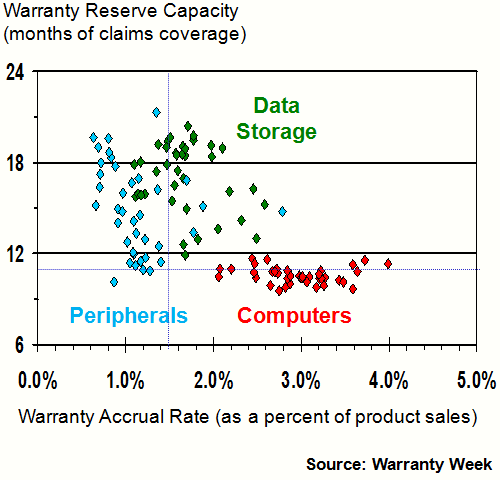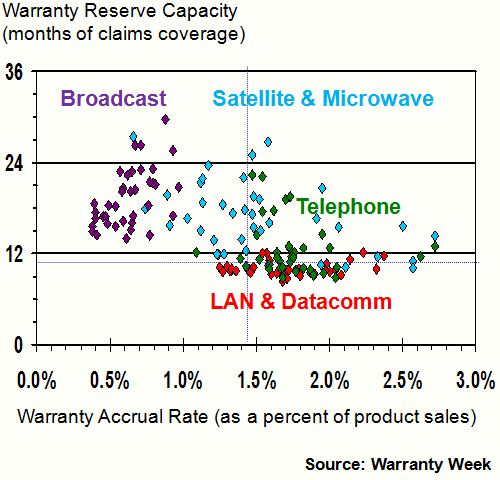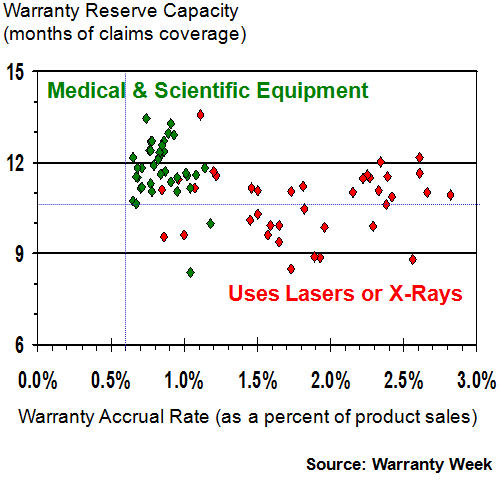Warranty Estimates, Part 1:
Companies are supposed to carefully estimate the size of their warranty liabilities. But sometimes, their estimates are too low, and the amount they set aside too meager to pay all their claims.
With warranty, companies are estimating future costs all the time. At the time a product is sold, a company estimates how much it expects to spend on warranty claims. And then it estimates whether it has enough in its warranty reserve to cover costs.
Or does it? Sometimes, those estimates turn out to be wrong. Other times, they're deliberately reduced so that perhaps only half the expected warranty cost is set aside at the time of sale. The other half is paid later, when hopefully sales are better and cash is more available.
Sometimes, a company guarantees its products with a three-year warranty but keeps only enough in its reserves to pay for the next year's claims. The second- and third-year costs will be funded later, when the bills come due. It's not a prudent way to run a warranty operation, but it's not illegal either. And it's very difficult to detect, because who's to say what will happen next year?
We could start with specific companies, but instead we'll dive into this subject from the top down. In this week's newsletter we'll look at four high-tech industries, and in future newsletters we'll look at the vehicle makers and the building trades.
Warranty Calculations
In each of the four charts below, we started with four metrics and ended up with two others. The first metric we collected was the dollar amount of product sales for the period in question. The second and third metrics were the amount spent on warranty claims, and the amount set aside as warranty accruals, during the same period. And the fourth metric was the ending balance in the warranty reserve fund.
We repeated these data collections for the 38 quarters between early 2003 and the middle of 2012. And we grouped the companies by the type of product they sold, or in cases where they fit into multiple categories, by the type of product that accounted for the most revenue.
Then we took the four basic metrics and combined them to create two new metrics. The amount set aside as warranty accruals was divided by the dollar amount of product sales for the period in question. This created a percentage that is labeled in the charts below as the accrual rate. For instance, if a company sells $10 million worth of product and sets aside $200,000 in warranty accruals, its accrual rate would be 2.0%.
Then we took the ending balance in the warranty reserve fund, and divided it by the amount being spent per month on warranty claims. This created a metric we're calling warranty reserve capacity, expressed as the number of months of claims coverage in the fund. For instance, if the reserve fund contained $6 million and the company was spending $500,000 a month on warranty claims, the reserve capacity would be 12 months.
The charts below track two key assumptions that a company has to monitor: how much should we set aside to pay future warranty claims, and are we keeping enough in reserve given the length of our warranties? In each industry, and for each product line, the answers will be different.
And of course, there's no one right answer for all the companies in a given industry. But by showing the averages of all the companies in a given industry or industry segment, we're tracking the best estimates of all those companies combined. So if one company is too high or too low, its competitors will blunt the impact of that error with their own assumptions.
Computer Industry
Let's start with the computer industry, and look at the quarterly accrual rates and reserve coverage of the computer OEMs, their data storage suppliers, and the makers of computer peripherals. As can be seen in the chart below, the computer OEMs generally have shorter warranties but higher accrual rates, while the data storage and peripheral makers have longer warranties but lower accrual rates.
Figure 1
U.S.-based Computer Industry
Warranty Accrual Rate & Reserve Coverage
January 2003 to June 2012
(as a % of revenue & in months)

The two dotted lines show the entire industry's averages as of June 2012. In the computer industry, the average warranty reserve capacity is 11 months, while the average accrual rate is 1.5%. In other words, all the manufacturers of computers, disk drives and peripherals set aside an average of 1.5% of their product revenue as warranty accruals, and keep the size of their warranty reserve equal to what they're spending on claims over the most recent 11 months.
However, the data storage industry's averages over the past 38 quarters, expressed by the 38 green diamonds on the chart, are generally higher than both these averages. The computer OEMs have higher average accrual rates, but less warranty reserve capacity than the average. And the peripheral makers have more months of claims coverage but lower accrual rates.
There's not always an exact correlation between the number of months of claims coverage and the average length of a company's warranties, but there should be. The actuarial goal, which seems to be enforced more stringently with extended warranties than product warranties, is that if you went into liquidation tomorrow, would there be enough money in your reserves to pay each and every last claim until all warranties expired? With extended warranties, you must. With product warranties, you should, but if you don't, you're probably not going to stay open long enough to honor your warranties anyhow. And by then, there are enough unpaid creditors and enough unfunded liabilities to keep the lawyers busy for years.
Telecom Equipment
In the telecommunications equipment industry, we've divided up the available population of 184 companies into four segments: the makers of broadcast equipment for radio and television networks, the makers of satellite and microwave equipment, mobile and landline telephone equipment, and finally local-area networks and other data communications gear for computers and the Internet.
In Figure 2, the four groups aren't as separate and distinct as they could be, but hopefully the color coding makes it easier to see the trend. The broadcast equipment makers have the lowest accrual rates and longer warranties. The satellite and microwave companies have longer warranties and slightly higher accrual rates.
The LAN and datacomm companies have the shortest warranties but tend to have higher accrual rates. The telephone equipment companies sometimes have as small a warranty reserve capacity, but sometimes more. And they also have generally higher than average accrual rates.
Figure 2
U.S.-based Telecom Equipment Industry
Warranty Accrual Rate & Reserve Coverage
January 2003 to June 2012
(as a % of revenue & in months)

Again, as before, the dotted lines show the June 2012 average for all the segments in the telecom industry. In this case, those values were 1.4% and 10.7 months -- slightly lower on both values than the computer industry.
Notice that across all segments, there are very few measurements above 24 months, and very few above 2.5%. At the other extreme, there are no measurements under 8 months or below 0.35%. And as with computers, there is a noticeable cluster close to 12 months, though in two or maybe three segments there are numerous data points between 12 and 24 months.
In the final two slides, there's more of a clear separation between the segments. In the first case, it's because of their different positions on the supply chain, and in the other, the difference has to do with the technologies used.
Semiconductor Industry
In the semiconductor and printed circuit board industry, there's a key difference between those who make the actual devices, and those who make the machines that make the devices. As can be seen in Figure 3 below, the companies making the actual devices have more reserves and less accruals, while those who make the manufacturing equipment have more accruals and less reserves.
Figure 3
U.S.-based Semiconductor & PCB Industry
Warranty Accrual Rate & Reserve Coverage
January 2003 to June 2012
(as a % of revenue & in months)

This could present something of a problem. If the manufacturing equipment companies are really keeping only about a year's worth of warranty reserves on hand, and if they really are setting aside 1.5% to 2.8% of sales as warranty accruals, what message are they sending to customers about preparedness?
If their warranties really last only a year, then the customers should be prepared for frequent and expensive repairs during the second and third years of ownership. But if the warranties do last multiple years, why aren't the manufacturers properly funding their liabilities?
Medical Equipment
There's a similar problem in the medical and scientific equipment industry. The 177 companies we're tracking generally keep their accrual rates just below one percent, and their warranty reserve capacity close to one year. But the equipment makers that manufacturer systems and devices that use X-rays and/or lasers, which require higher accrual rates to finance higher claims costs, generally aren't keeping enough in their warranty reserves to pay all their existing liabilities.
In Figure 4, we can see that on at least four occasions, the makers of medical equipment that uses lasers or X-rays allowed their reserve capacity to drop below 9 months. In fact, on only three occasions was their reserve capacity above 12 months. The other 31 quarters were between 9 and 12 months.
Figure 4
U.S.-based Medical Equipment Industry
Warranty Accrual Rate & Reserve Coverage
January 2003 to June 2012
(as a % of revenue & in months)

Are they really selling sophisticated and expensive equipment with only 9-to-12-month warranties? Or are they underfunding their warranty liabilities? It's OK if they do, as long as they remain in business. But when the bills come due, they will not have enough in their warranty reserves to pay them, and net earnings will take a hit as one-time additions are made. And if they go bankrupt or are acquired, the lawyers will discover an unfunded liability that will continue creating costs for years.
Reducing Warranty Costs
One reason for the horizontal spread of the red diamonds that represent the laser and X-ray equipment manufacturers is the success they've had in recent years at reducing their warranty expenses. However, remember that accruals rates fall because claims rates fall. And as claims rates fall, the warranty reserve capacity should go up.
It didn't. As of June 2012, the key averages for just the 24 makers of laser and X-ray equipment were 8.5 months and 1.7%. Claims were about the same as accruals, so the combined warranty reserve balance was steady at $100 million. But those warranty reserves would run out in March 2013 if there were no further accruals, and if claims continued to be paid at the same rate. The money would run out before the warranties ended.
Of course, this would never happen. The manufacturers will add accruals every time they sell a machine. And they will honor all warranty claims until those warranties expire on time. But they're underfunding their warranty liabilities, and that should make their customers a bit nervous. Usually, a promise is enough. But it would be more comforting if there was enough in the reserve fund at all times to pay all valid claims on all product sold by that date.








